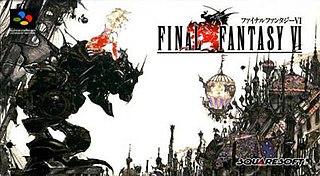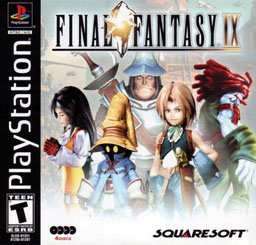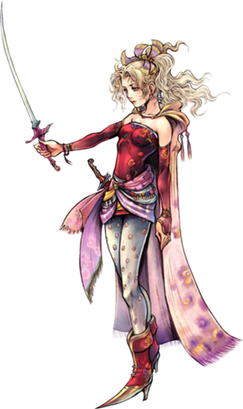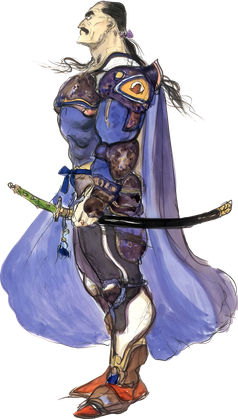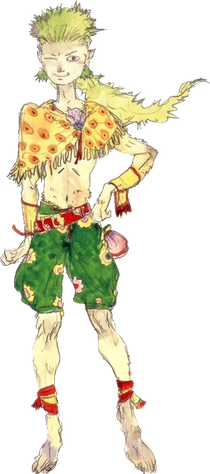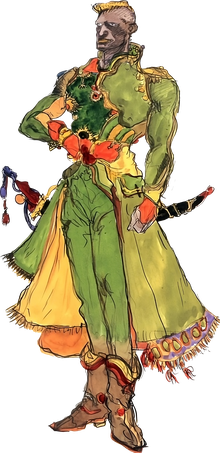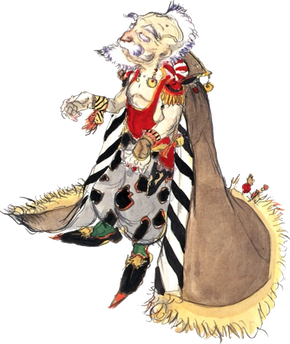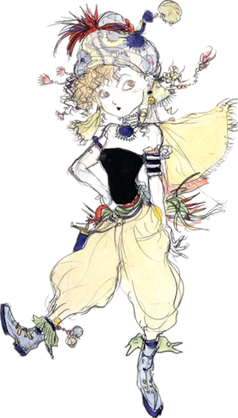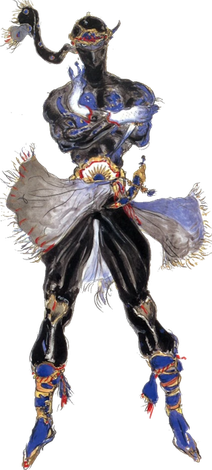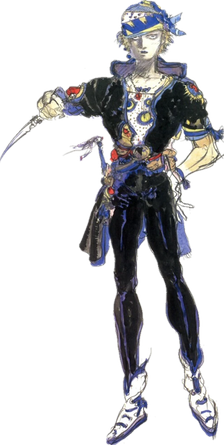Concept and creation
Edgar and Sabin were created for Final Fantasy VI by graphic designer Soraya Saga (real name Kaori Tanaka), who was responsible for the development of Sabin and Edgar, including their backstory and dialogue. [1] [2] They are twin brothers, with one living in the mountains to train while the other serves as the king of Figaro Castle. [3] Their middle names, Rene and Roni respectively, are used for the names of the brothers Roni and Reni Fatima from Xenogears , a game that Saga and her husband Tetsuya Takahashi worked on. [4]
Edgar is infatuated with women; according to Saga, this infatuation is due to the loss of his mother. He was also influenced by an older woman he had a crush on, a cousin to his father, who insisted he become a good man, leading him to aspire to be chivalrous. Her death caused him to seek out women who had a similar "spiritedness and lively wit." [2] Edgar was initially conceived as a "sleazeball," but Saga felt it was too cliched, so she removed that aspect. [2]
Saga discussed how Sabin had a surrogate family in the form of characters Gau and Cyan Garamonde; Gau because they both lost a father, and Cyan because he lost his child. She also noted that Sabin sees himself in Gau, as both have a connection to nature. [2] In the World of Ruin scene, Sabin was originally able to die, which would trigger a scene where Edgar trying to save him. This was changed after it was decided that this part of the game was dark enough without it. [2]
Appearances
Edgar and Sabin first appear in Final Fantasy VI . Before the events of the game, their father, the king of Figaro Castle, dies, and one of them has to assume the throne. Neither wants to, with Sabin wanting to live on his own and seek vengeance after discovering that their father was poisoned by the Gestahlian Empire They agree to decide who can go free based on a coin flip, which Sabin wins. It is later revealed that the coin was a two-headed coin, used by Edgar to guarantee Sabin's freedom. [3] During the war between the Gestahlian Empire and the Returners, Edgar played both sides in order to maintain peace in Figaro Castle, though aware that Emperor Gestahl and one of its generals, Kefka Palazzo, were too volatile for peace between Figaro and the Empire to last. [1]
After escaping from Narshe with Terra Branford, Locke Cole brought her to Figaro to get Edgar's help and protect her from the Empire. Kefka learns of Terra's presence here, forcing Edgar to use the kingdom's submersible capabilities to descend into the sand. Meanwhile, he, Terra, and Locke escape on Chocobo to escape and find a man named Banon, a member of the Returners. They travel through Mt. Kolt, where they are attacked by a man named Vargas, who served under the same master as Sabin. During the battle, Sabin appears and defeats him, ultimately joining their cause. The group eventually arrives at the Returners base and meets Banon, though Terra, Locke, Sabin, and Banon are forced to escape on a raft after the Empire attacks. While on the river, an octopus named Ultros attacks. Sabin ends up splitting up with the group to chase after Ultros by jumping into the river, while Edgar, Terra, and Banon continue on the raft. The game splits up here between three perspectives: Locke's, Sabin's, and Terra, Edgar, and Banon's, detailing how they all eventually reunite in Narshe. [1]
Sabin awakens, washed up on the Veldt, where he travels through territory under siege by the Empire, assisted by various characters. These include a ninja named Shadow and a knight from the Doma Castle named Cyan Garamonde, who had just survived the mass poisoning of Doma Castle by an Imperial soldier named Kefka Palazzo. They eventually traveled to the Phantom Forest after getting through Imperial soldiers, where they found the Phantom Train. Sabin boarded it with them, and the train began to move. They eventually managed to disembark after defeating the Phantom Train. Shadow leaves the group, and Sabin and Cyan leap down a waterfall, where they are saved from drowning by a feral boy named Gau, whom they befriend. [1]
When Edgar, Terra, and Banon arrive at Narshe, they were turned away by the guards, though they found an alternate entrance through a cave, allowing them to try persuading Narshe to join their cause. Locke and Sabin, accompanied by Celes Chere, Cyan, and Gau, eventually reunite with them in Narshe, and it is discovered that Narshe is poised to be attacked by the Empire, led by Kefka, who intended to kill all civilians. Edgar and Sabin work with the others to successfully ward off the attack, though Terra leaves after meeting a creature called an Esper, prompting the group to go looking for her. The group eventually convinces con-man Setzer Gabbiani to allow the use of his airship after he loses a coin toss with Celes, realizing too late that it was Edgar's two-headed coin but agreeing to the deal nonetheless. [1]
Edgar and Sabin assist the group in their battle against the Empire, Edgar managing to avoid being betrayed in a peace talk by getting information out of someone through flirting. They eventually pursue Kefka and Gestahl to the Floating Continent. Despite their efforts, Kefka was able to destroy the world by disrupting the three goddesses of magic, making the world inhospitable and causing the allies to be scattered and killing Gestahl. At this point, Sabin becomes an optional character, and can be found when Celes visits a town and finds him holding up a collapsing building to save the children inside. After Celes helps save them, Sabin joins her. [1]
Celes eventually finds a man calling himself Gerad, whom Celes and Sabin recognize as Edgar, though he denies this. He works with a group of thieves to try to enter Figaro Castle, and Celes and Sabin pursue him, eventually discovering that Figaro Castle was encumbered by giant tentacles preventing it from functioning properly. Edgar reveals his true identity, and assists Celes and Sabin in defeating the tentacles. He reveals that he needed to get into his castle, and joined with thieves who were planning to infiltrate it themselves. He then joins them on their quest. They later find Setzer again, eventually convincing him to join them so they can use his airship to encounter Kefka and defeat him. Other characters who were encountered before may be encountered again, though they are all optional. The group eventually makes their way to Kefka Tower, where they eventually fight and defeat Kefka. [1]
The two appear in a doujinshi created by Soraya Saga titled Figaro no Kekkon, which explores their backstory, though his is not an official work. [2] [1]
Reception
Edgar and Sabin received generally positive reception. In the book The Legend of Final Fantasy VI: Creation - Universe - Decryption, the author discusses both Edgar and Sabin. They discussed how Edgar was, in a way, his own coin, noting how he was a king who pursued women, an ally to both the Returners and the Empire, and defies conventions while remaining in control. They noted that this matched the themes of duality in the story, and how his brotherhood also did that. They argued that Edgar and Sabin formed a complete character, where Edgar was the brains and Sabin the brawn. They felt that Gerad, the persona Edgar adopted in the World of Ruin, represented a version of Sabin, where Edgar had to abandon his carefree attitude to assume the burden of responsibilities. They drew comparisons between the relationship between Edgar and Sabin to that of the brothers Edward and Alphonse Elric from Fullmetal Alchemist , commenting that despite being "as complementary to each other as they are different ... their approach to life remains similar." They also discussed how Sabin and Gau were the only ones who shaped their destiny through pure strength, whom they discussed as a brother figure to Sabin. They also focused on how Sabin chooses to let his actions speak for himself, citing how, when he fought Vargas, he chose to spare Vargas' life, [1]
The coin clip was considered a significant moment to Game Informer writer Kimberley Wallace, particularly due to the message that people's accomplishments are possible through "invisible hands of those that we love." She discussed how it initially seemed like just a twist of fate, but the realization that the coin flip was rigged in Sabin's favor communicates that "those who love us will sacrifice so that we can keep our pride and independence." [3] RPGamer writer Kelley Ryan discussed how Edgar was a standout king among kings in role-playing games, which she felt were a "dime-a-dozen" normally, describing him as being "full of charm [with] a unique hobby [while being] arguably the most powerful character in the game." She appreciated that, while flirting with Terra when they first meet, he treats her as a person, not interested in her magic abilities. She also appreciated his engineering prowess, demonstrated in both his castle being designed to submerge into the sand and his array of tools in combat. [5]
A moment in the game where Sabin uses one of his moves, the Suplex, on the Phantom Train to suplex it into the ground, has become a famous scene, with writer Sebastian Deken finding it a particularly interesting use of his skills despite considering it likely that the developers did not intend for this scene. [6] [7] Game Informer writer Adam Biessenger expressed a desire for Edgar and Sabin to be the stars of Final Fantasy VI instead of Terra. He was particularly enamored with Edgar's willingness to sacrifice his own happiness for Sabin, as well as Sabin's ability to suplex a train. [8] In the Pixel Remaster version of Final Fantasy VI, Sabin was still able to perform the technique on the Phantom Train, though because it did not turn upside down like the original, some fans were critical of this version. This caused Square Enix to respond, clarifying that this would be rectified by launch. [6]

